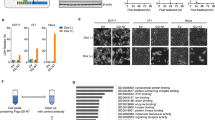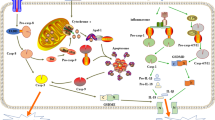Abstract
RGD motif-containing peptides have been used in various studies of cell adhesion and growth. We report that RGD triggered apoptosis at a concentration of 1 mmol/L, whereas RAD-containing peptides failed to induce apoptosis in HL-60 cells. RGD-treated cells revealed internucleosomal DNA fragmentation. Western blot reveals caspase-3 activation in RGD peptide-treated cells. A caspase-3 inhibitor z-VAD-FMK completely blocked the apoptosis, but a caspase-1 inhibitor (Ac-YVAD-CMK) and caspase-2 inhibitor (z-VDVAD-FMK) did not block the apoptosis, suggesting that caspase-3 might have a critical role in the execution process of apoptosis induced by RGD. RGD peptides have been used extensively to inhibit tumor metastasis. Our results should help in further understanding the RGD peptide-induced apoptosis, which is important since RGD peptides have a potential role in therapies of the future.
Similar content being viewed by others
References
Allen RT, Hunter WJ, Agrawal DK. Morphological and biochemical characterisation and analysis of apoptosis. J Pharmacol Toxicol. 1997;37:215-28.
Buckley CD, Pilling D, Henriquez NV, et al. RGD-peptides induce apoptosis by direct caspase-3 activation. Nature. 1999;397:534-9.
Carson DA, Ribeiro JM. Apoptosis and disease. Lancet. 1993; 341:1251-4.
Chen X, Wang J, Fu B, Yu L. RGD-containing peptides trigger apoptosis in glomerular mesangial cells of adult human kidneys. Biochem Biophys Res Commun. 1997;234:594-9.
Earnshaw WC. Nuclear changes in apoptosis. Curr Opin Cell Biol. 1995;7:337-43.
Fadok VA, Voelker DR, Campbell PA, Bratton DL, Henson PM. Exposure of phosphatidylserine on the surface of apoptotic lymphocytes triggers specific recognition and removal by macrophages. J Immunol. 1992;148:2207-16.
Frisch SM, Francis H. Disruption of epithelial cell-matrix interactions induces apoptosis. J Cell Biol. 1994;124:619-26.
Gerschenson LE, Rotello RJ. Apoptosis: a different type of cell death. FASEB J. 1992;6:2450-5.
Jacobson MD. Programmed cell death: a missing link is found. Trends Cell Biol. 1997;7:467-9.
Koopman G, Reutelingsperger CPM, Kuitjen GAM. Annexin V for flow cytometric detection of phosphatidyl serine expression of B cells undergoing apoptosis. Blood. 1995;84: 1415-19.
Meredith JE, Schwartz MA. Integrins, adhesion and apoptosis. Trends Cell Biol. 1997;7:146-50.
Nicholson DW, Thornberry NA. Caspases: killer proteases. Trends Biochem Sci. 1997;22:299-306.
Pasqualini R, Koivunen E, Ruoslahti E. A peptide isolated from phage display libraries is a structural and functional mimic of an RGD-binding site on integrins. J Cell Biol. 1995;130:1189-96.
Porter AG, Janicke RU. Death substrates come alive. Bioessays. 1997;19:501-7.
Ruoslahti E. RGD and other recognition sequences for-integrins. Ann Rev Cell Dev Biol. 1996;12:697-715.
Ruoslahti E, Pierschbacher MD. Arg-Gly-Asp: a verasatile cell recognition signal. Cell. 1986;44:517-8.
Salvesen GS, Dixit VM. Caspases: intracellular signalling by proteolysis. Cell. 1997;91:443-6.
Thornberry NA, Lazebnik Y. Caspases: enemies within. Science. 1998;281:1312-16.
Vermes I, Haanen C, Steffens-Nakken H, Reutelingsperger C. A novel assay for apoptosis. Flow cytometric detection of phosphatidylserine expression on early apoptotic cells using fluorescein labelled Annexin V. J Immunol. 1995;184:39-51.
Werb Z. ECM and cell surface proteolysis: regulating cellular ecology. Cell. 1997;91:439-42.
Wyllie AH. Glucocorticoid-induced thymocyte apoptosis is associated with endogenous endonuclease activation. Nature. 1980;284:555-6.
Wyllie AH, Kerr JFR, Currie AR. Cell death: the significance of apoptosis. Int Rev Cytol. 1980;68:251-306.
Xia Z, Bergstrand A, Depierre JW, Nassberger L. The anti-depressants imipramine, clomipramine and citalopram induce apoptosis in human acute myeloid leukemia HL-60 cells via caspase-3 activation. J Biochem Mol Toxicol. 1999; 13:338-47.
Zou H, Henzel WJ, Liu XS, Lutschg A, Wang XD. APAF-1, a human protein homologous to C-elegans ced-4, participates in cytochrome-c dependent activation of caspase-3. Cell. 1997;90:405-13.
Author information
Authors and Affiliations
Rights and permissions
About this article
Cite this article
Anuradha, C., Kanno, S. & Hirano, S. RGD peptide-induced apoptosis in human leukemia HL-60 cells requires caspase-3 activation. Cell Biol Toxicol 16, 275–283 (2000). https://doi.org/10.1023/A:1026758429238
Issue Date:
DOI: https://doi.org/10.1023/A:1026758429238




